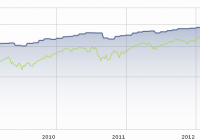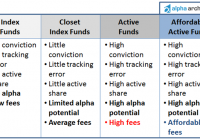RiverPark Structural Alpha Fund, December 2014
Editor’s note: Originally published on December 1, 2014 by David Snowball Objective and Strategy The RiverPark Structural Alpha Fund seeks long-term capital appreciation while exposing investors to less risk than broad stock market indices. The managers invest in a portfolio of listed and over-the-counter option spreads and short option positions that they believe structurally will generate exposure to equity markets with less volatility. They also maintain a short position against the broad stock market to hedge against a market decline and invest the majority of their assets in cash alternatives and high quality, short-term fixed income securities. Adviser RiverPark Advisors, LLC. RiverPark was formed in 2009 by former executives of Baron Asset Management. The firm is privately owned, with 84% of the company being owned by its employees. They advise, directly or through the selection of sub-advisers, the seven RiverPark funds. Overall assets under management at the RiverPark funds were over $3.5 billion as of September, 2014. Manager Jeremy Berman and Justin Frankel. The managers joined RiverPark in June 2013 when their Wavecrest Partners Fund was converted into the RiverPark Structural Alpha Fund. Prior to co-founding Wavecrest, Jeremy managed Morgan Stanley’s Structured Solutions group for eastern U.S.; prior to that he held similar positions at Bank of America and JP Morgan. Before RiverPark and Wavecrest, Mr. Frankel managed the Structured Investments business at Morgan Stanley. He began his career on the floor of the NYSE, became a market maker for a NASDAQ, helped Merrill Lynch grow their structured products business and served as a Private Wealth Advisor at UBS. They also graduated from liberal arts colleges (hah!). Strategy capacity and closure Something on the order for $3-5 billion. The derivatives market is “incredibly liquid,” so that the managers could accommodate substantially more assets by simply holding larger positions. Currently they have about 35 positions; by their calculation, a 100-fold increase in assets could be accommodated with a doubling of the number of positions. The unique nature of this market means that “more positions would decrease volatility without impinging returns. Given our portfolio structure, there’s no downside to growth.” Active share Not calculable for this sort of fund. Management’s stake in the fund Each of the managers has between $100,000 – 500,000 in the fund, as of the January 2014 Statement of Additional Information. RiverPark’s president is the fund’s single biggest shareholder; both he and the managers have been adding to their holdings lately. Two of the fund’s three trustees have substantial investments in the fund, which is particularly striking since they receive modest compensation for their work as trustees. In broad terms, they’ve invested hundreds of thousands more than they’ve received. We’d also like to compliment RiverPark for exemplary disclosure: the SEC allows funds to use “over $100,000” as the highest report for trustee ownership. RiverPark instead reports three higher bands: $100,000-500,000, $500,000-1 million, over $1 million. That’s really much more informative than the norm. Opening date June 28, 2013, though the preceding limited partnership launched on September 26, 2008. Minimum investment The minimum initial investment in the retail class is $1,000 and in the institutional class is $100,000. Expense ratio Retail class at 2.00% after waivers, institutional class at 1.75% after waivers, on total assets of $9.1 million. While that is high in comparison to traditional stock or bond funds, it’s competitive with other alt funds and cheap by hedge fund standards. If Wavecrest’s returns were recalculated assuming this expense structure, they’d be 2.0 – 2.5% higher than reported. Comments It’s time to get past having one five-word phrase, repeated out of context, define your understanding of an options-based strategy. In his 2002 letter , Warren Buffett described derivatives as (here are the five words): “financial weapons of mass destruction.” Set aside for the moment the fact that Buffett invests in derivatives and has made hundreds of millions of dollars from them and take time to read his original letter on the matter. His indictment was narrowly focused on uncollateralized positions and Buffett now has backed away from his earlier statement (“I don’t think they’re evil per se. It’s just, they, I mean there’s nothing wrong with having a futures contract or something of the sort”). His latest version of the warning is couched in terms of what happens to the derivatives market if there’s a nuclear strike or major biological weapons attack. I suspect that Messrs. Berman and Frankel would agree that, in the case of a nuclear attack, the derivatives market would be in trouble. As would the stock markets. And my local farmer’s market. Indeed, all of us would be in trouble. Structural Alpha is designed to address a far more immediate challenge: where should investors who are horrified by the prospects of the bond market but are already sufficiently exposed to the stock market turn for stable, credible returns? The managers believe that have found an answer which is grounded in one of the enduring characteristics of investor (read: “human”) psychology. We hate losing and we have an almost overwhelming fear of huge losses. That fear underlies our willingness to overpay for car, life, homeowners or health insurance for decades (the average U.S. house suffers one serious fire every 300 years, does that make you want to drop your fire coverage?) and is reflected in the huge compensation packages received by top insurance company executives (the average insurance CEO pockets $8 million/year, the CEO of Aetna (NYSE: AET ) took in $30 million). They make that money because risk is overpriced. Berman and Frankel found the same is true for volatility. Investors are willing to systematically overpay to manage the risks that make them most anxious. A carefully structured portfolio has allowed Structural Alpha and its predecessor limited partnership to benefit from that risk aversion, and to offer several distinctive advantages to their investors. Unlike an ETF or other passive product, this is not simply a mechanical collection of options. The portfolio has four complementary components whose weighting varies based on market conditions. Long-dated options which rise as the stock market does. The amount of the rise is capped, so that the fund trades away the prospect of capturing all of a bull market run in exchange for consistent returns in markets that are rising more normally. Short-dated options (called “straddles and strangles,” for reasons that are beyond me) which are essentially market neutral; they generate income and contribute to alpha in stable or range-bound markets. A short position against the stock market, designed to offset the portfolio’s exposure to market declines. A lot of high-quality, short-term fixed income products. Most of the fund’s portfolio is in cash, which serves as collateral on its options. Investing that cash carefully generates a modest, consistent stream of income. Over the better part of a full market cycle, the Structural Alpha strategy captured 80% of the stock index’s returns – the strategy gained about 70% while the S&P rose 87% – while largely sidestepping any sustained losses. On average, it captures about 20% of the market’s down market performance and 40% of its up market. The magic of compounding then works in their favor – by minimizing their losses in falling markets, they have little ground to make up when markets rally and so, little by little, they catch up with a pure equity portfolio. Here’s what that looks like: The blue line is Structural Alpha (you’ll notice it largely ignoring the 2008 crash) and the green line is the S&P 500. The dotted line is the point that Wavecrest became RiverPark. From inception, this strategy turned $10,000 into $16,700 with very low volatility while the S&P reached $19,600. The chart offers a pretty clear illustration of the managers’ goal: providing equity-like returns (around 9% annually) with fixed income-like volatility (around 30% of the stock market’s). There are two other claims worth considering: The fund benefits from market volatility, since the tendency to overpay rises as anxiety does. The fund benefits from rising interest rates, since its core strategies are uncorrelated with the bond market and its cash stash benefits from rising rates. Mr. Frankel notes that “if volatility and interest rates return to their historic means, it’s going to be a significant tailwind for us. That’s part of the reason we’re absolutely buying more shares for our own accounts.” That’s a rare combination. Bottom Line Fear causes us to act poorly. This is one of the few funds designed to allow you to use other’s fears to address your own. It seems to offer a plausible third path to reasonable returns, away from and independent of traditional but historically overpriced asset classes. Investors looking to lighten their bond exposure or dampen their equity portfolio owe it to consider Buffett’s actions rather than just his words. They should look closely here. Fund website RiverPark Structural Alpha. The managers lay out the research behind the strategy in The Benefits of Systematically Selling Volatility (2014), which is readable and well worth reading. If you’d like to listen to a précis of the strategy, they have a cute homemade video on the fund’s webpage. Start listening at about the 4:00 minute mark through to about 6:50. They make a complex strategy about as clear as anyone I’ve yet heard. The stuff before 4:00 is biography and the stuff afterward is legalese. Disclosure : No positions

